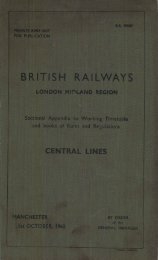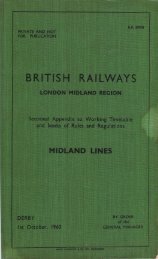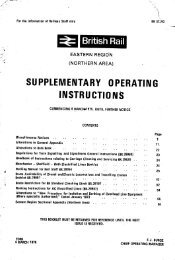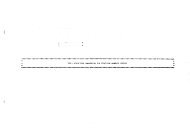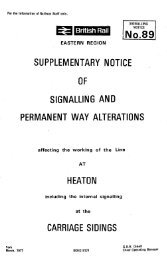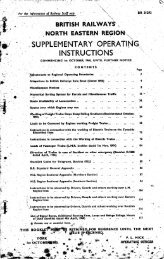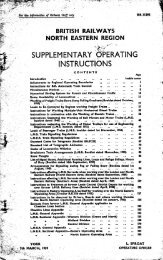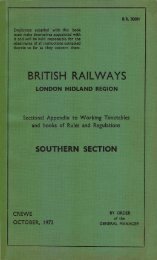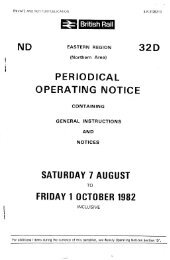general instructions. - Limit Of Shunt
general instructions. - Limit Of Shunt
general instructions. - Limit Of Shunt
Create successful ePaper yourself
Turn your PDF publications into a flip-book with our unique Google optimized e-Paper software.
60 G e n e r a l <strong>instructions</strong>.—Continued.<br />
SPEClAL STOP MADE BY PASSENGER TRAMS TO TAKE UP<br />
C G E T zo'xi7<br />
, General Rules 105 and 106.<br />
4 P A C S<br />
When a special stop is authorised in accordance with Rule 105,• for the<br />
E<br />
purpose of taking up or setting down passengers, the necessary fixed signals<br />
must be exhibited against E the train, and the <strong>instructions</strong> contained in Rule.<br />
106 carried out. R 3 .<br />
A special stop order form must be used in all cases where passenger<br />
trains make conditional stops to set down in accordance with the <strong>instructions</strong><br />
shewn in the Time Tables. Such orders to be handed to the drivers as well<br />
as the guards in charge of the trains.<br />
EXAMINATION OF TRAINS.<br />
General Rule •I 07 (a).<br />
On the arrival of through trains at intermediate stations at which carriage<br />
and wagon examiners are appointed, and where the trains have to be examined,<br />
the examiners must be in attendance and complete their work as early as<br />
possible, and when the work is completed the Chief Carriage or Wagon<br />
Examiner must immediately advise the person responsible for starting the<br />
train that the examination is finished. When brake examination is also<br />
undertaken, the brake examiners must inform the Chief Carriage or Wagon,<br />
Examiner when the brake examination is' completed, and until he receives<br />
this assurance the latter must not give the " All-right " signal to the person<br />
responsible for starting the train.<br />
At the following places the regulation will not apply 'under the circumstances<br />
set out below :—<br />
Middesbrcugl j<br />
,, and Harrogate f time. (O. 7329).<br />
WHaydon h e Bridge n<br />
and Ain/1100h<br />
t h e r<br />
So far as passenger trains are concerned, when the Examiner<br />
is engaged with Goods and Mineral trains.<br />
Ferryhill e<br />
i s<br />
To any trains except through Goods trains and Special<br />
Salt trains from Haverton Hill. ( O . 3077).<br />
m o<br />
r e<br />
t h<br />
DAMAGE TO ROLLMG STOCK.<br />
a n General Rules 107, 108, 115, 192, 196, 206, 209, and 211.<br />
o 1.—Guards in charge of trains must, in addition to making the usual entry<br />
nin<br />
their hand-books, report verbally or otherwise at the first opportunity to,<br />
e the Carriage and Wagon Examiners when vehicles forming part of their trains<br />
thave been r derailed, stopped for hot journals, or damaged in any way, giving<br />
name of the owner and number of the damaged vehicle or vehicles, and such<br />
a i<br />
other information as the Carriage and Wagon Examiner 'requires.<br />
n<br />
2.—Guards in charge ,<br />
i<br />
occurs of Gin othe o couplings d s of any wagon, secure the defective parts, and hand<br />
n them<br />
a<br />
over<br />
n d<br />
to the nearest Wagon Inspector, or take such steps as will secure<br />
this t being done. A remark of the occurrence must be made on the Guard's<br />
journal,<br />
M i n e r a<br />
h and the owner and number of the wagon must also be shewn<br />
l<br />
e<br />
t r a i<br />
s t<br />
n s<br />
a t<br />
m u s<br />
i o<br />
t ,<br />
n




